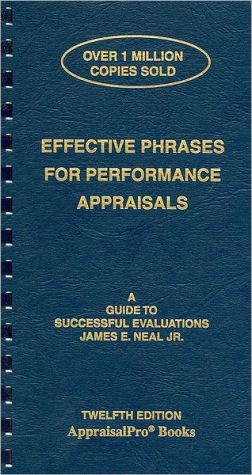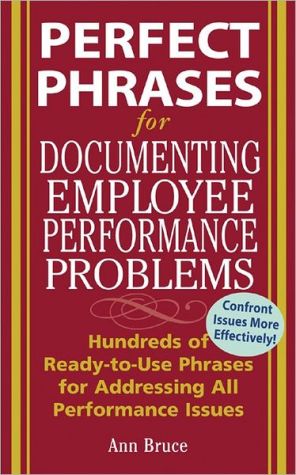101 Tough Conversations to Have with Employees: A Manager's Guide to Addressing Performance, Conduct, and Discipline Challenges
Inappropriate attire, lateness, sexually offensive behavior, not to mention productivity and communication issues ... these are just a few of the uncomfortable topics bosses must sometimes discuss with their employees. 101 Tough Conversations to Have with Employees offers realistic sample dialogues managers can use to facilitate clear, direct interactions with their employees, helping them sidestep potential awkwardness and meet issues head-on.\ This practical, solution-oriented book walks...
Search in google:
Inappropriate attire, lateness, sexually offensive behavior, productivity and communication issues... these are just a few of the uncomfortable topics you may have to discuss with your employees. 101 Tough Conversations to Have with Employees provides you with proven guidance and realistic sample dialogues you can use to facilitate clear, direct interactions with your people, helping to sidestep potential awkwardness and meet issues head-on. Brian Walton - Library Journal Falcone (vice president, Human Resources, Time Warner Cable; 2600 Phrases for Effective Performance Reviews), offers HR guidance here by giving us the beginnings of 101 tough conversations a manager may need to have with staff members. Grouped roughly by type of problem, the conversations each include a scenario, outline a solution with a sample piece of dialog, and alert the reader to potential legal or HR entanglements that might arise from the situation. Whether the book is of any use will depend on how comfortable the reader is in assuming Falcone's voice. The conversations generally follow a set pattern: force employees to admit their mistakes, make them feel guilt over it, extract their commitment to improve, and outline consequences if they don't. The sample dialogs themselves are apparently entirely fabricated, occasionally far-fetched, and begin to sound very similar over the course of the book. Those who have read Falcone's other books may want to pick this up for completeness, but most would be better served with something like Phillip L. Hunsaker and Tony Alessandra's more nuanced The Art of Managing People.
Introduction: The Rules of Engagement\ To make employee turnarounds and epiphanies successful, there are a\ few key rules of communication to follow: First, remember that it’s not\ what you say but how you say it that counts. That may sound like an old\ saying that your grandparents taught you, but in the world of work, people\ tend to respond in kind: If you demonstrate respect and compassion,\ you’re likely to receive a similar response, even when dealing with the\ most uncomfortable and confrontational workplace situations.\ Second, your greatest asset when dealing with others is guilt, not\ anger. Anger is an external response: When people are mad at another\ person, they look outward to voice their frustration. Guilt, on the other\ hand, is internal: When people feel guilty, they look inward and tend to\ assume responsibility for the problem at hand. That’s the Golden Rule of\ Workplace Leadership: Allow people to assume responsibility for their\ actions, and you’ll ‘‘pierce their heart’’ and get them to want to change\ things for themselves. Try to force them to do something by making them\ mad or by challenging or embarrassing them, and they’ll resist the change\ that’s being forced on them. We’ll discuss strategies for invoking guilt\ rather than anger responses throughout the book, and psst . . . this works\ just as effectively in your personal life as well!\ Third, remember that whatever you want for yourself, give to another.\ So many times people demand respect, open communication, and other\ forms of social acceptance without realizing that they don’t give those\ things to others. At a time when many demographers and sociologists are\ pointing to major shortages in the labor market because of the upcoming\ retirement of the baby boom generation, retention is vital. Yet people\ tend to join companies and leave managers: They initially see the value\ of the company, its reputation, and perception as a great place to work—\ only to flee from a manager whom they no longer trust or respect.\ They also say that the difference between an active and a passive job\ seeker is one bad day in the office. When that proverbial straw breaks,\ sometimes over seemingly minor issues, the job change mechanism kicks\ into gear, and at best you’ll have a worker who has become mentally\ unemployed. Then you’re faced with the ‘‘employees who quit and leave’’\ versus the ‘‘employees who quit and stay’’ syndrome, and it’s only a matter\ of time until something blows up.\ Folks, life is too short! And if your company is anything like the typical\ company in corporate America, there’s usually enough work to sink a battleship.\ You certainly don’t need all the added angst and pressure that\ comes from walking on eggshells around people who you really don’t get\ along with. That’s simply too much for most people to bear, and yes,\ there’s a better way to manage your career as well as your subordinates.\ Which leads us to the fourth rule of thumb: Honesty is the best policy.\ Now I know what you’re thinking: Oh please, that’s very easily said\ from the HR ivory tower, but I’ve got to work side by side with these\ people every day, so please spare me the hackneyed adages! Being open\ and honest is particularly difficult when you’re dealing with certain kinds\ of employees, and the confrontation just isn’t worth it.’’\ In reality, honesty has to be the basis of everything you do as a leader.\ Confrontation is tough for all of us. Just remember that differences in\ opinion are perfectly acceptable; however, confrontation in the negative\ sense is optional. Speaking with others in a respectful and thoughtful\ tone, regardless of the content of your message, will allow them to assume\ responsibility for their actions or, in the case of termination, get on with\ their lives. Try these on for size:\ >> Janet, I appreciate all of your hard work and effort over the past three\ months, but we’re at the end of your probation period, and I’m sorry to\ say that this just isn’t working for us. I know how hard you’ve tried to\ improve in light of the discussions we’ve had, and I’d guess that you probably\ feel that it’s not a ‘‘love connection’’ on your end either, but I don’t\ believe this was a good match of your strengths to our needs, and I’m\ afraid we’ll have to separate your employment today. We’ll label this as a\ ‘‘probationary termination’’ in our records, and you’ll still be eligible for\ rehire with the company if some other opportunity surfaces in the future.\ In addition, we won’t contest your ability to get unemployment insurance.\ >> Sam, through absolutely no fault of your own, our company is going\ through a restructuring, and we’re going to have to eliminate a number of\ positions. Yours is unfortunately one of them, and I’m so sorry. I wish it\ could be different, and we’ll do whatever we can to help you through this\ unexpected transition in your career, but please understand that these\ sorts of things do happen in people’s careers, and I’m afraid that your\ position is impacted as part of a larger restructuring. We’ll discuss a number\ of ways that we’d like to help you, but before we go much further with\ this discussion, I just want to check and make sure you’re okay. . . .\ No, these examples aren’t exactly fun messages to deliver, but they’re\ compassionate and understanding. You’ll more than likely find that people\ are willing to meet you halfway and become part of the solution any\ time you present issues that affect them personally—even terminations\ and layoffs—with kindness and concern.\ In the first example, the probationary employee being terminated for\ cause will certainly feel remorseful—‘‘I didn’t want to lose this job and\ I’ve tried so hard. I’m sorry if I disappointed you, and truth be told, I’ve\ disappointed myself’’—but probably not litigious. Remorse and regret\ stem from guilt: ‘‘I was part of the problem and couldn’t increase my\ performance to a level that was acceptable to the company.’’ And guilt\ always looks internally for shared responsibility and accountability.\ In the second example, the layoff was no one’s fault. These things\ simply happen, and the supervisor was very caring and willing to say, ‘‘I’m\ so sorry.’’ Those three words are critical and so underused! It costs nothing\ to say I’m sorry, as it costs nothing to say thank you, but few supervisors\ make consistent use of those magic words. When employees sue companies\ for wrongful termination, one of the first things they typically complain\ of is, ‘‘I can’t believe after all I had done for that company, they\ threw me out and never even said they were sorry!’’ That need to hear I’m\ sorry is a universally human trait, so don’t be shy about using those very\ words. It’s fair, humane, and fills a very important need in others’ lives.\ In fact, a lawsuit is typically a tool of workplace revenge. When employees\ feel like they were stripped of their dignity, humiliated, or disrespected\ at the time when they were most vulnerable, they often feel a\ need to get back at the company. We all know about incidents of workplace\ violence and lawsuits that plague the workplace, but imagine how\ much easier it would be to treat people fairly and respectfully at the time\ of their greatest vulnerability and allow them to get on with their lives.\ Just think how you’d like to be treated under those same circumstances,\ and use yourself as a guide for handling the situation.\ That being said, don’t manage by fear of a lawsuit, and don’t be afraid\ of being sued because that’s simply the cost of doing business from time\ to time in corporate America. You should be concerned, however, that\ you are being sued on your terms—not theirs. And that means that you\ should always be prepared to defend a termination or other adverse action\ by showing that you were a reasonable and responsible employer\ and that you accorded employees with workplace due process. In other\ words, the record should reflect that you listened to the employee’s side\ of the story, investigated the situation thoroughly and objectively, and\ reached a reasonable and timely conclusion before taking action. That\ may sound simple, but it can be difficult to avoid acting in the heat of\ the moment when something goes wrong in the office or on the shop\ floor.\ Finally, the fifth and most important rule in this book is actually a\ word: perception. Perception is never right or wrong—it just is. And\ whenever you use the word perception, you’re not accusing anyone of\ anything or proclaiming to be stating facts. Instead, you’re simply relaying\ how you’re seeing things from your perspective or what you’re hearing\ from others.\ Let’s look at the most common problem with people management in\ corporate America today: grade inflation during performance reviews.\ Performance reviews are often mandatory in many companies and\ needed to justify an employee’s annual merit increase. But because many\ supervisors don’t keep records of their employees’ performance throughout\ the year or meet with their staff members on a quarterly or interim\ basis, they have little information on which to justify the grades they give.\ They of course want to avoid upsetting the employee, whom they have to\ deal with for the entire upcoming year, so rather than providing an honest\ grade showing that the person doesn’t meet company expectations,\ they inflate the grade to show that the person is performing at an acceptable—\ albeit not stellar—level.\ Well, this scenario goes on for several years, and low and behold, the\ company suddenly finds itself in dire straights and decides it must lay off\ a certain percentage of its workforce. The manager, of course, wants to\ lay off the marginal performer (i.e., the one who’s been ‘‘skating by’’ in a\ quasi-job that produces few results). However, not realizing that the\ paper record created over the past few years shows that this individual\ has consistently met expectations, the supervisor is shocked to find that\ he or she can’t simply lay off the true substandard performer.\ Why not? Because more often than not, that particular employee is\ the longest tenured, the oldest, or otherwise the most protected person\ in the group. The fact that you gave this person an overall performance\ review score of 3—meeting expectations—while everyone else on the\ team got a 4 or a 5—exceeding expectations—means little in the grand\ scheme of things. That’s because the employee ‘‘heard’’ that she met company\ expectations for the entire year with an overall acceptable score.\ Whether she knew that her 3 was the lowest score in the group isn’t\ really at issue because overall performance review scores are absolute, not\ relative. In other words, if her overall score was a 3, then it doesn’t matter\ if that was the lowest score in the group: A score of 3 still ‘‘meets’’ company\ expectations, and that’s the only message that really counts in terms\ of the record your company has created.\ At that point, human resources or your outside legal counsel becomes\ a barrier that’s standing in your way of getting done what you want and\ need done, and then you’re at odds with your own internal support team.\ It’s a lose-lose situation because you weren’t honest and upfront in your\ conversations with this subordinate all along, and now you’re kicking\ yourself (and anyone else in your path) for not allowing you to get your\ way. The end result? You have to lay off someone less tenured on your\ team (who happens to be your star performer) and now begin the progressive\ discipline process with the laggard employee from scratch—even\ though she should have been disciplined a long time back.
Preface xiAcknowledgments xvIntroduction: The Rules of Engagement 1Part I Uncomfortable Workplace Situations1 Common Managerial and Supervisory Discussions 9Scenario 1 Mediating Disputes Among Subordinates 9Scenario 2 Appropriate Responses to Requests to Speak "Off the Record" 13Scenario 3 Promoting a Neophyte into a First-Time Supervisory Role 15Scenario 4 New Supervisor Syndrome 18Scenario 5 Inheriting an Employee with Disciplinary Problems 20Scenario 6 Stopping Attitude Problems in Their Tracks 23Scenario 7 Advice Before a Holiday Party or an Offsite Event 242 Individual Appearance and Uncomfortable Workplace Dilemmas 28Scenario 8 Bad Hair Days 29Scenario 9 Inappropriate Dress 32Scenario 10 Body Piercing and Body Art 33Scenario 11 Tattoos 34Scenario 12 Halitosis (Bad Breath) 36Scenario 13 Body Odor from Lack of Cleanliness 37Scenario 14 Body Odor from Suspected Medical Reason 393 Cultural and Religious Differences 42Scenario 15 Inappropriate Display of Religious Icons 43Scenario 16 Supervisor Proselytizes to Subordinates 47Scenario 17 Offensive Food Preparation and Spicy Smells 49Scenario 18 Euphemisms like "Honey," "Sweetie," and "Doll" 50Scenario 19 Speaking Foreign Languages in the Workplace 53Scenario 20 Inappropriate Display of Sexually Explicit Material 55Scenario 21 Lack of Understanding of Multicultural Differences 58Part II Poor Work Habits and Job Performance Concerns4 Performance Transgressions 63Scenario 22 Lack of Quality, Detail, or Efficiency 64Scenario 23 Lack of Quantity or Speed 66Scenario 24 Substandard Customer Satisfaction 69Scenario 25 Lack of Sales Production71Scenario 26 Failure to Learn New Material During Training 73Scenario 27 Acts Resulting in a Loss to the Employer 76Scenario 28 Failure to Follow Through, or "Dropping the Ball" 785 Policy and Procedure Violations 81Scenario 29 Failure to Adhere to Safety Rules 82Scenario 30 Excessive Personal Telephone Calls 84Scenario 31 Excessive Time Spent on the Internet 86Scenario 32 Unauthorized Use of Company Equipment and Facilities 89Scenario 33 Working Unauthorized Overtime 91Scenario 34 Off-Duty Conduct and Moonlighting 946 Excessive Absenteeism and Tardiness 98Scenario 35 Excessive Unscheduled Absence: "No Fault" System 103Scenario 36 Excessive Unscheduled Absence: "Excuse-Based" System 105Scenario 37 Patterning Excessive, Unscheduled Absence Around Weekends 107Scenario 38 Rolling Calendar Year Maneuvers 108Scenario 39 Excessive Tardiness 110Scenario 40 Exempt Employees Who Choose to Come and Go as They Please 1127 Lack of Requisite Skills 115Scenario 41 Inferior Job Knowledge 116Scenario 42 Lack of Technical Skills 118Scenario 43 Inadequate Problem-Solving Skills 121Scenario 44 Substandard Written Expression 123Scenario 45 Poor Time Management 125Scenario 46 Lack of Organization and Neatness 128Part III Inappropriate Workplace Behavior and Conduct8 Sexually Offensive Behavior 135Scenario 47 Foul Language in the Workplace 136Scenario 48 E-Mail Misuse 139Scenario 49 Finding Pornography on an Employee's Computer 142Scenario 50 Bullying 144Scenario 51 Discriminatory Comments or Racial Epithets 147Scenario 52 Leering 149Scenario 53 Sexual Harassment Findings (Reverse Harassment) 1529 Substandard Communication Skills 156Scenario 54 Tattletales, Gossipmongers, and Snitches 158Scenario 55 Whiners and Complainers 161Scenario 56 Requests for Confidential Conversations from Other Supervisors' Subordinates 163Scenario 57 Poor Listening Skills 166Scenario 58 Failure to Communicate Upward 169Scenario 59 Establishing Effective Staff Meetings 17110 Personal Style Issues 174Scenario 60 Suspected Alcoholism or Substance Abuse 174Scenario 61 Inability to Accept Constructive Criticism 179Scenario 62 Lack of Sensitivity and Protocol (E-Mail Censuring) 181Scenario 63 Badgering and Challenging One's Supervisor 183Scenario 64 Lack of Teamwork and Relationship-Building Skills 186Scenario 65 Laziness and Lack of Commitment 188Scenario 66 Blamers and Excuse Makers 191Scenario 67 Coworker Jealousy and Employees Who Can't Let Go of Their Anger 193Scenario 68 Supremacists-Arrogance and Superior Attitudes 19411 Leadership Style Challenges and Career Management Obstacles 197Scenario 69 Stalled Career Syndrome 198Scenario 70 Unwillingness to Confront Problems Head-On 201Scenario 71 Staff Motivation Conversations 204Scenario 72 Protecting Your Company from Legal Liability (Documentation) 207Scenario 73 Inability to Provide Constructive Criticism 210Scenario 74 Handling Group Complaints Wisely 212Scenario 75 Lack of Diversity Awareness 216Scenario 76 Lack of Leadership 218Part IV Corporate Actions12 Corporate (Intentional) Actions 225Scenario 77 Probationary Termination 226Scenario 78 Administering Disciplinary Warnings 229Scenario 79 Administering Decision-Making Leaves 231Scenario 80 Termination for Cause (in Conjunction with Progressive Discipline) 235Scenario 81 Convincing an Employee to Leave Voluntarily When There Are No Progressive Disciplinary Warnings on File 237Scenario 82 Negotiating a Separation Package When There Are No Progressive Disciplinary Warnings on File 24013 Corporate ("No Fault") Actions 244Scenario 83 Layoff: Position Elimination-LIFO 245Scenario 84 Layoff: Position Elimination-Lack of Qualifications 247Scenario 85 Layoff: Position Elimination-Union Bumping Privileges 250Scenario 86 Layoff: Position Elimination-Department Closure 254Scenario 87 Layoff: Position Elimination-Plant Closure (WARN Act) 256Scenario 88 Follow-Up Discussions with Survivors After Layoffs Occur 25814 Summary Offenses (Immediate Discharge) 262Scenario 89 Employee Theft 263Scenario 90 Selling Proprietary Products on the Internet 265Scenario 91 Time Card Fraud 268Scenario 92 Threats of Violence in the Workplace 269Scenario 93 Sexual Harassment 271Scenario 94 Falsification of Company Records 274Scenario 95 Insubordination 27615 Special Circumstances 280Scenario 96 Welcoming Back Employees Returning from a Stress Leave of Absence 281Scenario 97 Dealing with Employees in Crisis: Isolation 285Scenario 98 Dealing with Employees in Crisis: Suicidal Concerns 288Scenario 99 Dealing with Employees in Crisis: Homicidal Concerns 290Scenario 100 Terminating Employees Who Are on Investigatory Leave 292Scenario 101 Verbally Accepting an Employee's Resignation 295Index 299
\ From the Publisher"The underlying premise of '101 Tough Discussions [sic]' is that if your employees are treated with respect, and workplace guidelines are clearly written and uniformly enforced, many problems can be avoided. But for the times when they can't, the advice in this book will be invaluable. It deserves a prominent pace in the office of anyone who is responsible for managing others." --Pittsburgh Post-Gazette\ \ \ \ \ \ Library JournalFalcone (vice president, Human Resources, Time Warner Cable; 2600 Phrases for Effective Performance Reviews), offers HR guidance here by giving us the beginnings of 101 tough conversations a manager may need to have with staff members. Grouped roughly by type of problem, the conversations each include a scenario, outline a solution with a sample piece of dialog, and alert the reader to potential legal or HR entanglements that might arise from the situation. Whether the book is of any use will depend on how comfortable the reader is in assuming Falcone's voice. The conversations generally follow a set pattern: force employees to admit their mistakes, make them feel guilt over it, extract their commitment to improve, and outline consequences if they don't. The sample dialogs themselves are apparently entirely fabricated, occasionally far-fetched, and begin to sound very similar over the course of the book. Those who have read Falcone's other books may want to pick this up for completeness, but most would be better served with something like Phillip L. Hunsaker and Tony Alessandra's more nuanced The Art of Managing People.\ —Brian Walton\ \ \







